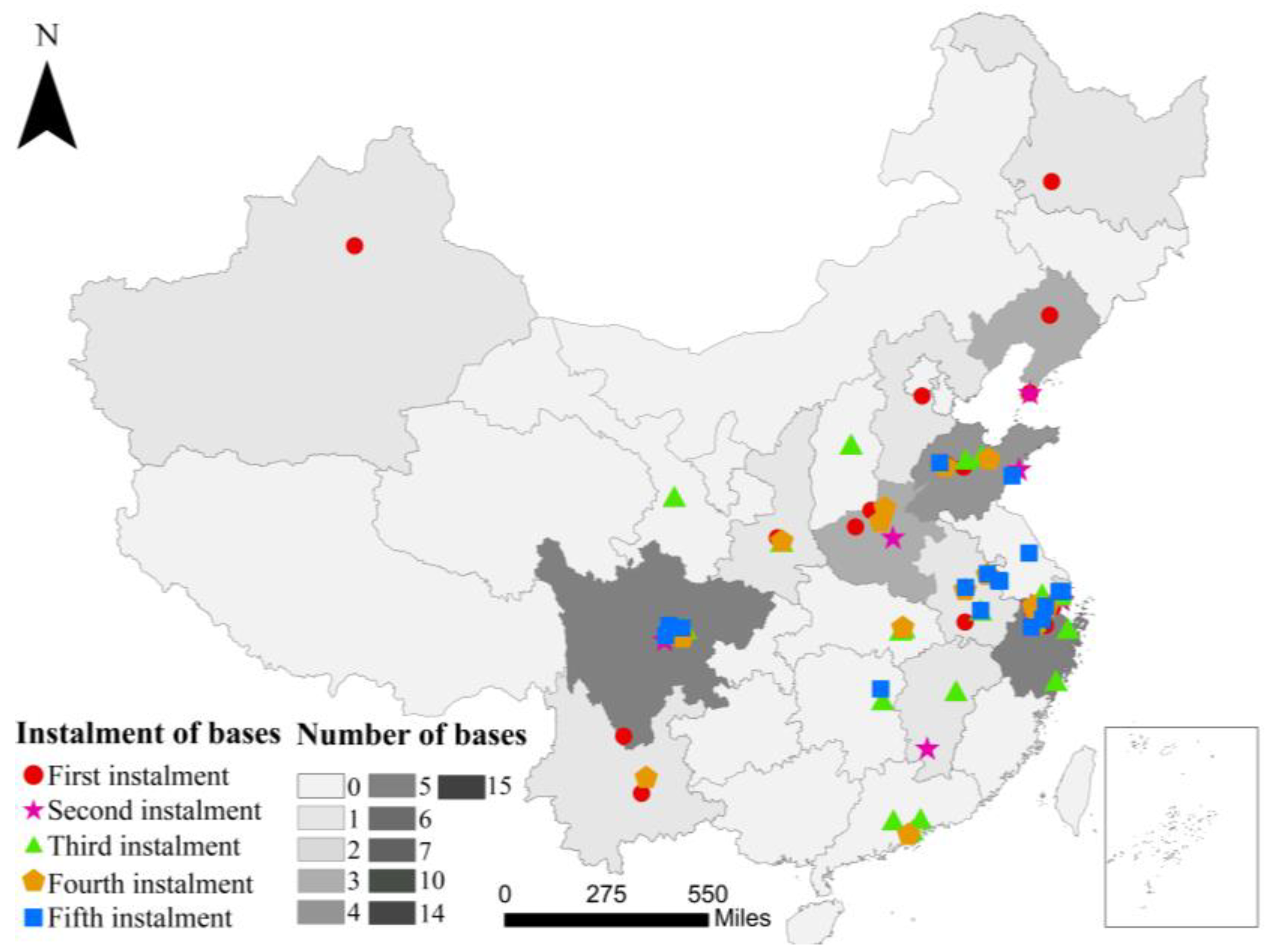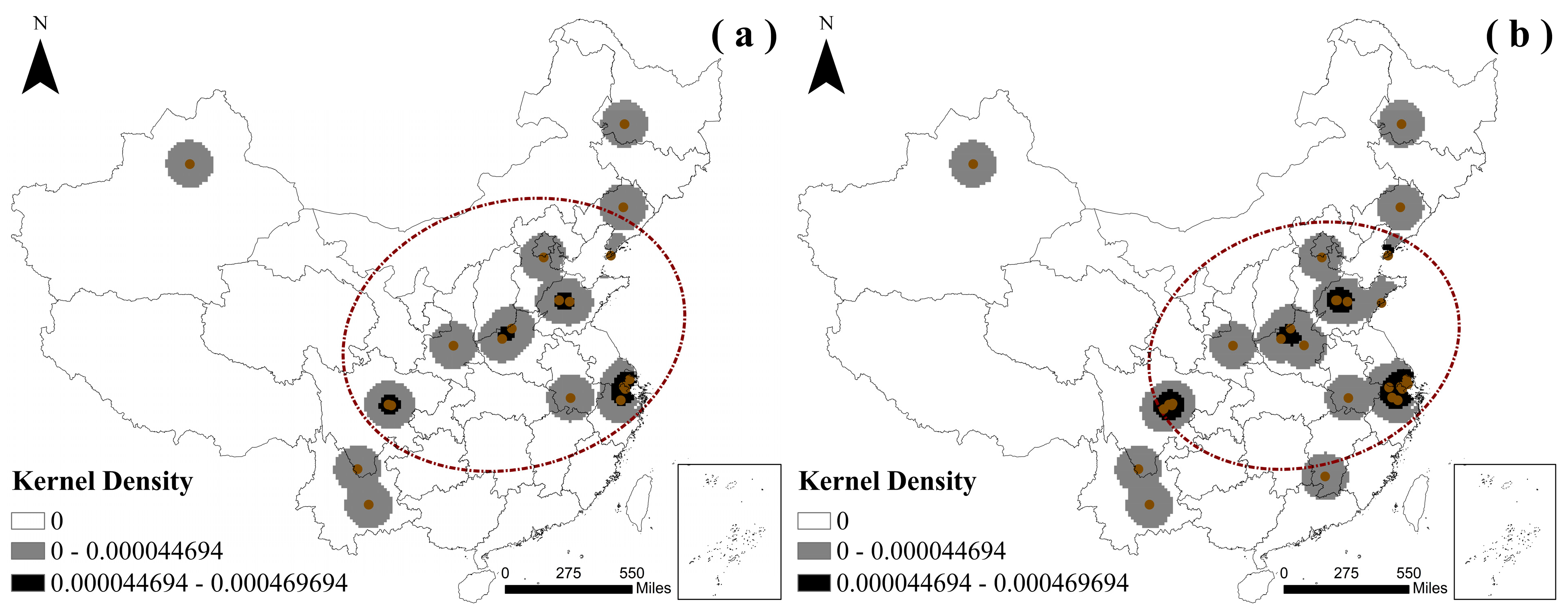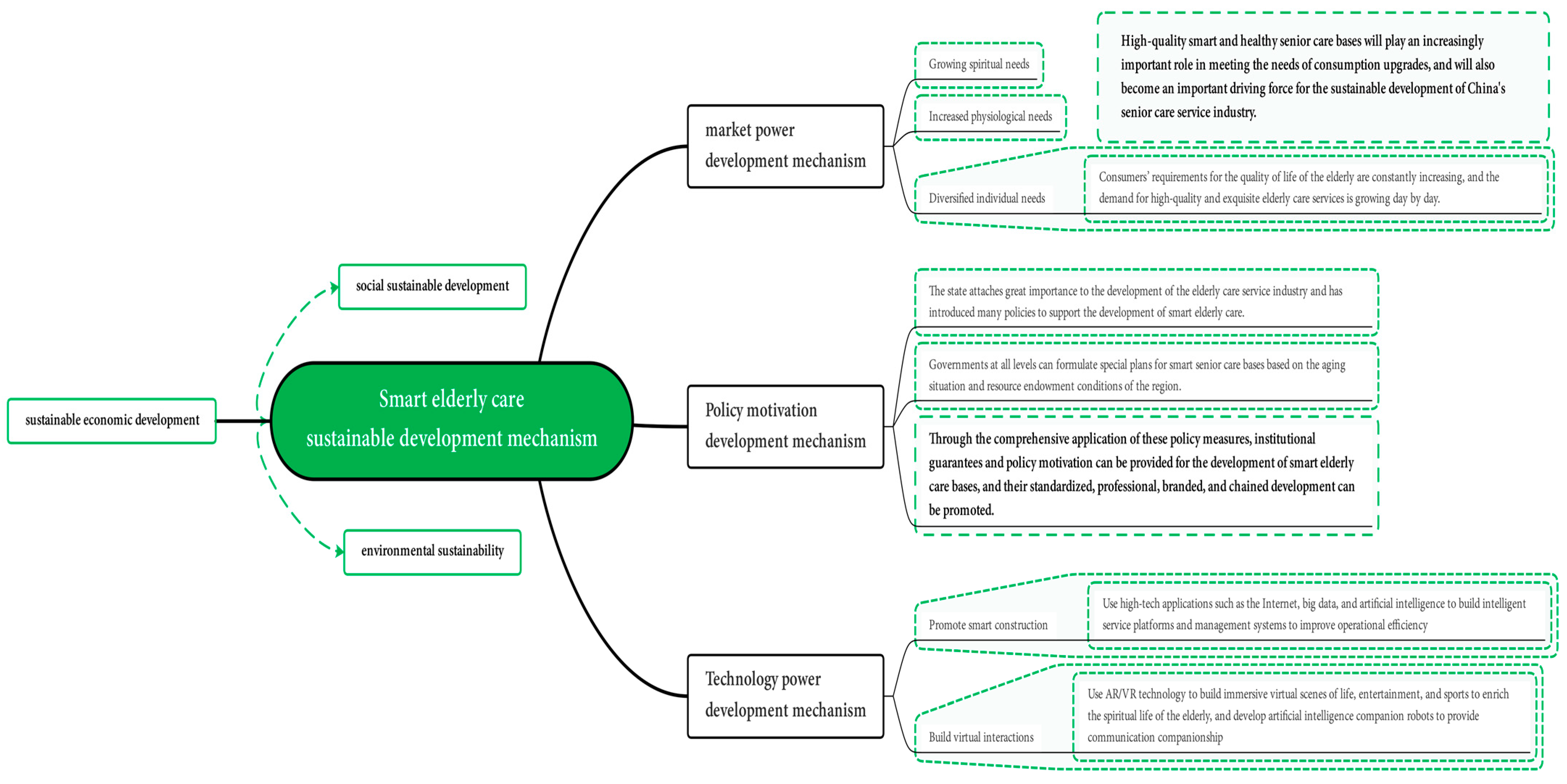Research on the Spatial and Temporal Distribution Evolution and Sustainable Development Mechanism of Smart Health and Elderly Care Demonstration Bases Based on GIS
Abstract
1. Introduction
2. Overview of the Study Area
3. Materials and Methods
3.1. Research Methods
3.1.1. Nearest Neighbor Index Method
3.1.2. Coefficient of Variation and PZ Value
3.1.3. Geographic Concentration Index
3.1.4. Kernel Density Analysis
3.1.5. Thiessen Polygon
3.1.6. Spatial Autocorrelation Analysis
- Moran index
- Getis-Ord index
3.2. Data Sources
4. Results
4.1. Spatial Distribution Types
4.2. Aggregation Characteristics of Spatiotemporal Distribution
4.3. Density Characteristics of Spatiotemporal Distribution
4.4. Spatial Correlation Features
5. Discussion of Sustainable Development Mechanism
5.1. Market Power Development Mechanism
5.2. Policy Motivation Development Mechanism
5.3. Technology Power Development Mechanism
6. Discussion and Conclusions
6.1. Discussion
6.2. Conclusions
6.3. Shortcomings and Prospects
Author Contributions
Funding
Institutional Review Board Statement
Informed Consent Statement
Data Availability Statement
Acknowledgments
Conflicts of Interest
References
- Cui, Z.; Jiaju, C.; Long, L. Megatrends, New Characteristics and Corresponding Pension Policies of Population Aging in China. Shandong Univ. J. 2016, 27–35. [Google Scholar]
- Zeping, R. China Aging Report. Dev. Res. 2023, 40, 22–30. [Google Scholar]
- Zhang, F.; Fang, D. Study on the Relationship among Population Aging, Urbanization and Rural-Urban Income Gap in China-Based on Panel VAR Model. J. Jilin Coll. Commer. Ind. 2015, 31, 9–14. [Google Scholar]
- Ning, Y. Challenges and Opportunities for China in the “Post-Demographic Dividend Era”-Based on the Perspective of the Economic Impact of Aging. Soc. Sci. 2013, 82–92. [Google Scholar]
- Fan, J.; Zhou, L.; Zhang, Y.; Shao, S.; Ma, M. How does population aging affect household carbon emissions? Evidence from Chinese urban and rural areas. Energy Econ. 2021, 100, 105356. [Google Scholar] [CrossRef]
- Hu, Y.; Wang, J.; Nicholas, S.; Maitland, E. The sharing economy in China’s aging industry: Applications, challenges, and recommendations. J. Med. Internet Res. 2021, 23, e27758. [Google Scholar] [CrossRef]
- Tu, W.; Zeng, X.; Liu, Q. Aging tsunami coming: The main finding from China’s seventh national population census. Aging Clin. Exp. Res. 2022, 34, 1159–1163. [Google Scholar] [CrossRef]
- Wei, C.; Yalong, G. Negative population growth and population aging in China. Beijing Soc. Sci. 2023, 101–112. [Google Scholar] [CrossRef]
- Fang, C. Supply-side and demand-side perspectives on the challenges of aging in China. Econ. Dyn. 2021, 27–34. [Google Scholar]
- Zhiqiang, C.; Jinqiu, M. The Evolution of Population Aging in China and Countermeasures. Acad. Exch. 2018, 101–109. [Google Scholar]
- Liu, L.; Wu, F.; Tong, H.; Hao, C.; Xie, T. The digital divide and active aging in China. Int. J. Environ. Res. Public Health 2021, 18, 12675. [Google Scholar] [CrossRef]
- Hou, L.; Liu, X.; Zhang, Y.; Zhao, W.; Xia, X.; Chen, X.; Lin, X.; Yue, J.; Ge, N.; Dong, B. Cohort profile: West China health and aging trend (WCHAT). J. Nutr. Health Aging 2021, 25, 302–310. [Google Scholar] [CrossRef]
- Liu, Y.; Tong, D.; Cheng, J.; Davis, S.J.; Yu, S.; Yarlagadda, B.; Clarke, L.E.; Brauer, M.; Cohen, A.J.; Kan, H. Role of climate goals and clean-air policies on reducing future air pollution deaths in China: A modelling study. Lancet Planet. Health 2022, 6, e92–e99. [Google Scholar] [CrossRef]
- Wu, L.; Huang, Z.; Pan, Z. The spatiality and driving forces of population ageing in China. PLoS ONE 2021, 16, e0243559. [Google Scholar] [CrossRef]
- Liu, N.; Cadilhac, D.A.; Kilkenny, M.F.; Liang, Y. Changes in the prevalence of chronic disability in China: Evidence from the China Health and Retirement Longitudinal Study. Public Health 2020, 185, 102–109. [Google Scholar] [CrossRef]
- Wang, Q.; Wang, L. The nonlinear effects of population aging, industrial structure, and urbanization on carbon emissions: A panel threshold regression analysis of 137 countries. J. Clean. Prod. 2021, 287, 125381. [Google Scholar] [CrossRef]
- Lu, N.; Spencer, M.; Sun, Q.; Lou, V.W. Family social capital and life satisfaction among older adults living alone in urban China: The moderating role of functional health. Aging Ment. Health 2021, 25, 695–702. [Google Scholar] [CrossRef]
- Qixiang, M.; Xiaomeng, P.; Chen, W. Research on the organic integration of modern agricultural science and technology park and elderly care industry base. Strait Technol. Ind. Mag. 2014, 85–87. [Google Scholar]
- Yanhui, L.; Qiuping, L.; Jinchen, H.; Yuqi, D.; Shiyi, S. An empirical analysis of the elderly’s satisfaction with smart community elderly care services and its influencing factors—A survey based on smart elderly care bases in some areas of Wuhan City. Mod. Commer. Ind. 2023, 44, 126–129. [Google Scholar]
- Song, J.H.; Wang, P.; Zhao, C.J. Analysis of Spatial Distribution Pattern of Main Tourism Resources in Hainan Island Based on GIS. In Proceedings of the Conference: Meeting 3rd International Conference on Ecosystem Assessment Management/Workshop on the Construc-tion of an Early Warning Platform for Eco-Tourism, Haikou, China, 5–12 May 2014; pp. 367–374. [Google Scholar]
- Crosetto, M.; Tarantola, S. Uncertainty and sensitivity analysis: Tools for GIS-based model implementation. Int. J. Geogr. Inf. Sci. 2001, 15, 415–437. [Google Scholar] [CrossRef]
- Jihong, G.; Shuigeng, Z.; Fuling, B.; Lingkui, M. Building distributed web GIS: A mobile-agent based approach. Wuhan Univ. J. Nat. Sci. 2001, 6, 474–481. [Google Scholar] [CrossRef]
- Giang, L.K.; Pei, L.; Tay, L.L. Determining the road traffic accident hotspots using GIS-based temporal-spatial statistical analytic techniques in Hanoi, Vietnam. Geo-Spat. Inf. Sci. 2020, 23, 153–164. [Google Scholar]
- Martino, F.; Sessa, S.; Barillari, U.E.S.; Barillari, M.R. Spatio-temporal hotspots and application on a disease analysis case via GIS. Soft Comput. 2014, 18, 2377–2384. [Google Scholar] [CrossRef]
- Weizhen, W.; Changen, W.; Zhiquan, G. Research and Application of Intelligent Pipeline Comprehensive Business Platform Based on GIS+BIM. Intell. Build. Smart Cities 2023, 165–167. [Google Scholar] [CrossRef]
- Xingwang, L.; Lanting, Z.; Zhuang, L.; Fan, L.; Nicolas, O. Optimization of spatial prediction and sampling strategy of site contamination based on Thiessen polygon coupling interpolation. Environ. Sci. Pollut. Res. Int. 2023, 30, 78959–78972. [Google Scholar]
- Dong, Z.; Bain, D.J.; Akcakaya, M.; Ng, C.A. Evaluating the Thiessen polygon approach for efficient parameterization of urban stormwater models. Environ. Sci. Pollut. Res. Int. 2022, 30, 30295–30307. [Google Scholar] [CrossRef]
- Lemmerz, T.; Herlé, S.; Blankenbach, J. Geostatistics on Real-Time Geodata Streams—High-Frequent Dynamic Autocorrelation with an Extended Spatiotemporal Moran’s I Index. ISPRS Int. J. Geo-Inf. 2023, 12, 350. [Google Scholar] [CrossRef]
- Yufan, W.; Wangyong, L.; Minjian, W.; Xu, C.; Yao, L. Application of improved Moran’s I in the evaluation of urban spatial development. Spat. Stat. 2023, 54, 100736. [Google Scholar]
- Griffith, D.A. Interpreting Moran Eigenvector Maps with the Getis-Ord Gi* Statistic. Prof. Geogr. 2021, 73, 447–463. [Google Scholar] [CrossRef]
- Wang, Z.; Lam, N.S. Extending Getis–Ord Statistics to Account for Local Space–Time Autocorrelation in Spatial Panel Data. Prof. Geogr. 2020, 72, 411–420. [Google Scholar] [CrossRef]
- Dongxia, Z.; Zenglin, H.; Li, W. Agglomeration pattern of elderly population distribution and its formation mechanism in China. Geo 2017, 72, 1762–1775. [Google Scholar]
- Lijuan, S.; Chaoqun, W. Regional Economic Differences, Dynamic Evolution and Convergence of Chinese Urban Agglomerations: A Study Based on the Nighttime Lighting Data of Ten Urban Agglomerations. Shanghai Econ. Res. 2021, 38–52. [Google Scholar] [CrossRef]
- Jianxiong, T.; Mengyao, M.; NIing; Qionghui, G. Characteristics of spatial differentiation and influencing factors of elderly care facilities in ChangZhuTan city cluster. Econ. Geogr. 2019, 39, 113–121. [Google Scholar]
- Yuqin, J.; Huiming, J. Analysis of spatial and temporal differences in the suitability of aging and elderly resources in the new era and their influencing factors. Geoscience 2022, 42, 851–862. [Google Scholar]
- Li, H.M. The Impact of Sustainable Development on the Public Health System of the Elderly in the Internet of Things Environment. Sustainability 2022, 14, 16505. [Google Scholar] [CrossRef]
- Suslo, A.; Mizia, S.; Horoch-Lyszczarek, E.; Pochybelko, E. The future of care and healthcare provision to community-dwelling disabled elderly people in an ageing society. Fam. Med. Prim. Care Rev. 2023, 25, 102–106. [Google Scholar] [CrossRef]
- Zhang, Q.; Li, M.Y.; Wu, Y.J. Smart home for elderly care: Development and challenges in China. BMC Geriatr. 2020, 20, 318. [Google Scholar] [CrossRef]
- Liu, X.Y.; Chau, K.Y.; Liu, X.X.; Wan, Y. The Progress of Smart Elderly Care Research: A Scientometric Analysis Based on CNKI and WOS. Int. J. Environ. Res. Public Health 2023, 20, 1086. [Google Scholar] [CrossRef]
- Cao, C.; Dai, H.Y.; Li, D. How to promote the healthy development of continuous participation in smart medical and elderly care systems: The dual perspective of perceived value and risk. Digit. Health 2023, 9. [Google Scholar] [CrossRef]
- Mostepaniuk, A.; Akalin, T.; Parish, M.R. Practices Pursuing the Sustainability of A Healthcare Organization: A Systematic Review. Sustainability 2023, 15, 2353. [Google Scholar] [CrossRef]
- Mengze, S.; Qian, G.; Zhigang, L.; Jian, J. A Study on the Evolution of China’s Pension Policy Based on Attribute Analysis and Text Clustering. Popul. Dev. 2023, 29, 133–144. [Google Scholar]
- Liyan, Z.; Haoyue, S. Research on China’s Smart Healthy Aging Policies under the Perspective of Healthy Aging—Based on the Analysis of Policy Texts from 2015 to 2020. Sci. Manag. 2022, 42, 27–33. [Google Scholar]
- Han, J.H.; Lee, J.Y. Digital Healthcare Industry and Technology Trends. In Proceedings of the 2021 IEEE International Conference on Big Data and Smart Computing (BIGCOMP 2021), Jeju Island, Republic of Korea, 17–20 January 2021; pp. 375–377. [Google Scholar]
- Gupta, P.; Choudhury, R.; Kotwal, A. Achieving health equity through healthcare technology: Perspective from India. J. Fam. Med. Prim. Care 2023, 12, 1814–1817. [Google Scholar] [CrossRef] [PubMed]
- Cavicchi, C.; Oppi, C.; Vagnoni, E. Back and Forth on Sustainable Development: A Focus on Healthcare Organisations. Sustainability 2022, 14, 4958. [Google Scholar] [CrossRef]






| Year | Number of Elderly Care Centers | Theoretical Nearest Neighbour Distance/km | Actual Nearest Neighbour Distance/km | Nearest Neighbour Index | Z-Score | Type of Space Structure |
|---|---|---|---|---|---|---|
| 2017 | 19 | 316.174 | 293.515 | 0.928 | −0.598 | Random |
| 2018 | 29 | 255.920 | 214.589 | 0.839 | −1.664 | Clustered |
| 2019 | 52 | 201.043 | 135.521 | 0.674 | −4.496 | Clustered |
| 2020 | 68 | 176.294 | 103.908 | 0.589 | −6.477 | Clustered |
| 2021 | 85 | 157.683 | 79.855 | 0.506 | −8.705 | Clustered |
| Year | Number of Elderly Care Centers | Number of Provincial Administrations | Imbalance Index (S) | Geographical Concentration Index (G) |
|---|---|---|---|---|
| 2017 | 19 | 12 | 0.263 | 32.015 |
| 2018 | 29 | 13 | 0.385 | 33.610 |
| 2019 | 52 | 19 | 0.442 | 30.285 |
| 2020 | 68 | 19 | 0.475 | 30.987 |
| 2021 | 85 | 19 | 0.492 | 31.282 |
Disclaimer/Publisher’s Note: The statements, opinions and data contained in all publications are solely those of the individual author(s) and contributor(s) and not of MDPI and/or the editor(s). MDPI and/or the editor(s) disclaim responsibility for any injury to people or property resulting from any ideas, methods, instructions or products referred to in the content. |
© 2024 by the authors. Licensee MDPI, Basel, Switzerland. This article is an open access article distributed under the terms and conditions of the Creative Commons Attribution (CC BY) license (https://creativecommons.org/licenses/by/4.0/).
Share and Cite
Chen, X.; Chen, B.; Zhang, H.; Wong, C.U.I. Research on the Spatial and Temporal Distribution Evolution and Sustainable Development Mechanism of Smart Health and Elderly Care Demonstration Bases Based on GIS. Appl. Sci. 2024, 14, 780. https://doi.org/10.3390/app14020780
Chen X, Chen B, Zhang H, Wong CUI. Research on the Spatial and Temporal Distribution Evolution and Sustainable Development Mechanism of Smart Health and Elderly Care Demonstration Bases Based on GIS. Applied Sciences. 2024; 14(2):780. https://doi.org/10.3390/app14020780
Chicago/Turabian StyleChen, Xiaolong, Bowen Chen, Hongfeng Zhang, and Cora Un In Wong. 2024. "Research on the Spatial and Temporal Distribution Evolution and Sustainable Development Mechanism of Smart Health and Elderly Care Demonstration Bases Based on GIS" Applied Sciences 14, no. 2: 780. https://doi.org/10.3390/app14020780
APA StyleChen, X., Chen, B., Zhang, H., & Wong, C. U. I. (2024). Research on the Spatial and Temporal Distribution Evolution and Sustainable Development Mechanism of Smart Health and Elderly Care Demonstration Bases Based on GIS. Applied Sciences, 14(2), 780. https://doi.org/10.3390/app14020780






